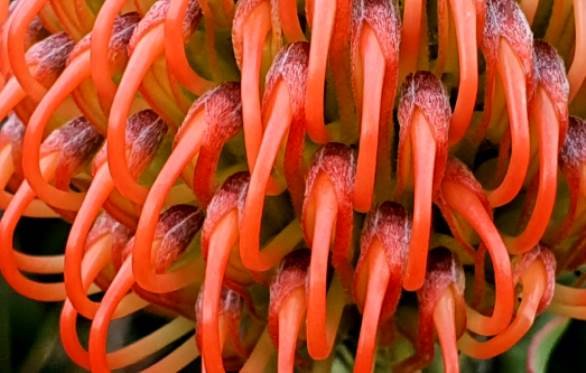Leucospermum cordifolium budding styles nearly breaking free

Author: Ivan Lätti
Photographer: Uri Mitrani
The wiry, orange styles of the nearly open Leucospermum cordifolium flowerhead all bulge outwards in concerted action, nearly at the same rate. Differences are by minutely graded increments in the group, emphasising coordinated action of the head as one whole.
The styles are destined to stand much taller than the perianths ever could when their ranks were closed earlier. Styles form the fully developed pincushion meant to be touched by pollinators. As the styles elongate, the perianths that cannot keep up with their length extension any longer, lose their grip and collapse in the base of the flowerhead, the styles eventually standing alone.
Perianths burst open along a seam of the outer of their four hairy segments, while each perianth tip holds on until its pollen is ripe. Perianth segment tip inside surfaces house the anthers. When the style breaks free, its cylindrical tip, now the pollen presenter, receives the pollen from the anthers that lay against them. Later the pollen presenter role is discarded when the style tip becomes truly female in function as the stigma.
Incoming food-seeking traffic, mostly insects and birds, oblige often enough in uploading this pollen from the presenters for later offloading elsewhere, hopefully on stigmas of the same species. Reconnoitring more florets continues as long as every visitor remains hungry.
And a little later pollen from another floret may be brought here in similar fashion. The pollen presenter turned stigma is then pollinated for fruiting to follow in the ovary below, unless something else goes wrong. Millions of repetitions are conducted to yield species seed set sufficient for survival.
Timing is often key in procreative matters, urgency not far behind (Manning, 2007; Leistner, (Ed.), 2000).

